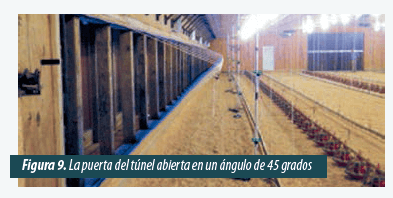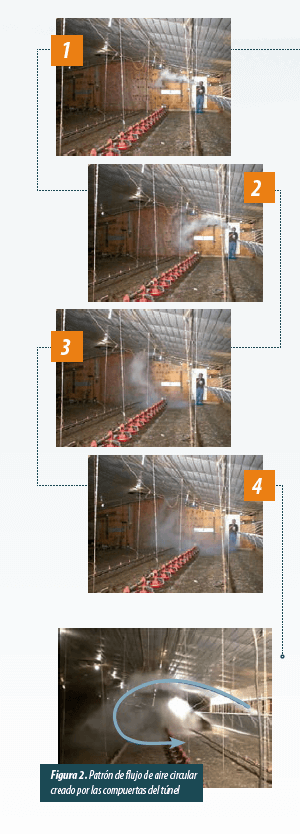Content available at: Español (Spanish)
Originally, tunnel doors were only thought of as a method of reducing heating costs and litter caking in the tunnel inlet area of totally-enclosed houses.
Poultry farmers realized that:
The heaters near the tunnel curtains running nearly constantly during cold weather, while the remaining heaters operated only occasionally.
Poultry farmers who installed gates at tunnel entrances, with greater thermal insulation and tightness, often saw significant reductions in heating costs , which is not surprising considering the tunnel inlet can extend over 1/3 of the of the length of the brooding area in many of today’s broiler houses ( Figure 1 ).
Something that many producers discovered which they didn’t expect was that tunnel doors often proved nearly as beneficial during hot weather as they did during cold weather.
Producers found that tunnel doors produced better air movement in the tunnel inlet area, eliminated the “dead spot” near the side wall just past the end of the tunnel opening.
Most importantly, they improved side wall-to-wall air velocity uniformity throughout a house, all of which helped to lessen heat-stress-related production problems often experienced during hot weather.
Houses with traditional tunnel curtains
Incoming air doesn’t tend to stir much as it enters and moves down the house. It comes straight into the center of the house, collides with the air entering through the opposing tunnel curtain opening, and moves down the house toward the tunnel fans without a significant level of circulation.
Houses with tunnel doors
The incoming air pattern is very different, resembling the air circulation pattern created by the side wall inlets during cold weather.
The angled opening of the tunnel door directs the incoming air up to and along the ceiling, where it remains until it reaches the center of the house where it collides with the incoming air from the opposite side of the house.
It then rolls down toward the floor and then back to the side wall, creating a circular air flow pattern (Figure 2).
This circular air flow pattern continues for about 30 meters as the air moves down the house towards the tunnel fans.

The benefits of circular air compared to that created by traditional tunnel curtain openings was demonstrated in two nearly identical 20.1 x 152.4 meter tunnel-ventilated broiler houses.
One of them was equipped with conventional tunnel doors that could only open to approximately a 50 degree angle.
The other was equipped with a type of tunnel door system that could be opened to the point where the doors were parallel to the floor, which created an air flow pattern similar to that produced by a traditional tunnel curtain opening.
The average air velocity in both houses was calculated, taking 15 air velocity measurements in the cross section at 18.3 meters from the tunnel fans end wall, when the 16 fans of 1.3 meters in diameter were operating.
Though the average air speed of the two houses was found to be nearly identical, averaging of 3.78 m / sec (+/- 0.08 m / sec) there was a large difference in wall-to-wall air speed uniformity between the two houses.
In the house with the tunnel doors open 50 degrees, the difference in air speed between the center of the house to within 1.5 meters from the side walls was less than 0.5 meters per second.
In contrast, in the house where the tunnel doors were able to be opened parallel to the floor, the variation was approximately 1.27m /sec (Figure 3), which would result in less of a cooling effect for the birds near the side walls compared to those toward the center of the house.

But, when the same tunnel doors were closed to a 45 degree angle, the side wall variation was decreased to less than 0.5 m / sec (Figure 4).
The conclusion from this study was very clear: simply getting the air to circulate as it enters greatly improves air speed uniformity along the entire length of a house.
From a tunnel door management standpoint, it is important to realize that not only does the degree at which tunnel doors are opened affect the birds hundreds of feet away from the tunnel door opening, it will also affect those birds directly under the tunnel door.
The more tunnel doors are opened, the more likely a dead air spot will be created under the tunnel door (Figures 5,6 and 7) . This is because the more a tunnel door opens the harder it is for the circulating air to make it all the way back to the
side wall under the tunnel doors.

By maximizing the tunnel door opening, the static pressure is minimized which would improve fan performance and therefore house air speed and bird cooling.
Though it is true that as the tunnel door opening is reduced, pressure will tend to increase. It is important to realize that there can be significant advantages to reducing the amount tunnel doors open.
Keep up to date with our newsletters
Receive the magazine for free in digital version
REGISTRATION
ACCESS
YOUR ACCOUNT
LOGIN
Lost your password?

















